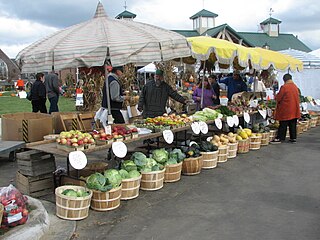
Guelph is a city in Southwestern Ontario, Canada. Known as The Royal City, it is roughly 22 km (14 mi) east of Kitchener and 70 km (43 mi) west of Downtown Toronto, at the intersection of Highway 6, Highway 7 and Wellington County Road 124. It is the seat of Wellington County, but is politically independent of it.

A grocery store (AE), grocery shop (BE) or simply grocery is a foodservice retail store that primarily retails a general range of food products, which may be fresh or packaged. In everyday U.S. usage, however, "grocery store" is a synonym for supermarket, and is not used to refer to other types of stores that sell groceries. In the UK, shops that sell food are distinguished as grocers or grocery shops.

Loblaw Companies Limited is a Canadian retailer encompassing corporate and franchise supermarkets operating under 22 regional and market-segment banners, as well as pharmacies, banking and apparel. Loblaw operates a private label program that includes grocery and household items, clothing, baby products, pharmaceuticals, cellular phones, general merchandise and financial services. Loblaw is the largest Canadian food retailer, and its brands include President's Choice, No Name and Joe Fresh. It is controlled by George Weston Limited, a holding company controlled by the Weston family; Galen G. Weston, is the chair of the Loblaw board of directors, as well as chair of the board of directors and CEO of Canada-based holding company George Weston.
Sobeys Inc. is the second largest supermarket chain in Canada after Loblaw Companies Limited, with over 1,500 stores operating across Canada under a variety of banners. Headquartered in Stellarton, Nova Scotia, it operates stores in all ten provinces and accumulated sales of more than C$25.1 billion in the fiscal 2019 operating year. It is a wholly owned subsidiary of Empire Company Limited, a Canadian business conglomerate.

A farmers' market is a physical retail marketplace intended to sell foods directly by farmers to consumers. Farmers' markets may be indoors or outdoors and typically consist of booths, tables or stands where farmers sell their produce, live animals and plants, and sometimes prepared foods and beverages. Farmers' markets exist in many countries worldwide and reflect the local culture and economy. The size of the market may be just a few stalls or it may be as large as several city blocks. Due to their nature, they tend to be less rigidly regulated than retail produce shops.

The Saskatchewan Party is a conservative political party in the Canadian province of Saskatchewan. The party was founded in 1997 by a coalition of former provincial Progressive Conservative and Liberal Party members who sought to unite opposition to the governing New Democratic Party. Since 2007, the Saskatchewan Party has been the province's governing party, and both the party and the province are currently led by Premier Scott Moe.

Peak oil is the point in time when the maximum rate of global oil production is reached, after which production will begin an irreversible decline. It is related to the distinct concept of oil depletion; while global petroleum reserves are finite, the limiting factor is not whether the oil exists but whether it can be extracted economically at a given price. A secular decline in oil extraction could be caused both by depletion of accessible reserves and by reductions in demand that reduce the price relative to the cost of extraction, as might be induced to reduce carbon emissions or from demand destruction triggered by persistently high oil prices.

SaskTel Centre is an arena located in Saskatoon, Saskatchewan, Canada. The facility opened in February 1988 and is currently the home venue of the Saskatoon Blades of the Western Hockey League, the Saskatchewan Rattlers of the Canadian Elite Basketball League, and the Saskatchewan Rush of the National Lacrosse League, with the arena being referred to as Co-op Field at SaskTel Centre during Rush games.
No Frills is a Canadian chain of discount supermarkets, owned by Loblaw Companies Limited, a subsidiary of George Weston Limited. There are over 200 franchise stores located in nine Canadian provinces.

Canada is one of the largest agricultural producers and exporters in the world. As with other developed nations, the proportion of the population agriculture employed and agricultural GDP as a percentage of the national GDP fell dramatically over the 20th century, but it remains an important element of the Canadian economy. A wide range of agriculture is practised in Canada, from sprawling wheat fields of the prairies to summer produce of the Okanagan valley. In the federal government, overview of Canadian agriculture is the responsibility of the Department of Agriculture and Agri-Food.
Through the 1996 Electric Utilities Act the Alberta's deregulated electricity market began.

Mike Schreiner is a Canadian politician who has served as the leader of the Green Party of Ontario since 2009. Schreiner sits as a member of Provincial Parliament (MPP), representing Guelph; his 2018 election made him the first Green Party member elected to the Legislative Assembly of Ontario.

Sylvain Charlebois is a Canadian researcher and professor in food distribution and policy at Dalhousie University in Halifax, Nova Scotia, Canada. He is a former dean of the university's Faculty of Management.

Groundhog Day is a tradition observed in the United States and Canada on February 2 of every year starting in the 16th century. It derives from the Pennsylvania Dutch superstition that if a groundhog emerges from its burrow on this day and sees its shadow, it will retreat to its den and winter will go on for six more weeks; if it does not see its shadow, spring will arrive early.
Food prices refer to the average price level for food across countries, regions and on a global scale. Food prices affect producers and consumers of food. Price levels depend on the food production process, including food marketing and food distribution. Fluctuation in food prices is determined by a number of compounding factors. Geopolitical events, global demand, exchange rates, government policy, diseases and crop yield, energy costs, availability of natural resources for agriculture, food speculation, changes in the use of soil and weather events directly affect food prices. To a certain extent, adverse price trends can be counteracted by food politics.
The Canadian property bubble refers to a significant rise in Canadian real estate prices from 2002 to present which some observers have called a real estate bubble. The Dallas Federal reserve rated Canadian real estate as "exuberant" beginning in 2003. From 2003 to 2018, Canada saw an increase in home and property prices of up to 337% in some cities. In 2016, the OECD warned that Canada's financial stability was at risk due to elevated housing prices, investment and household debt. By 2018, home-owning costs were above 1990 levels when Canada saw its last housing bubble burst. Bloomberg Economics ranked Canada as the second largest housing bubble across the OECD in 2019 and 2021. Toronto scored the highest in the world in Swiss bank UBS' real estate bubble index in 2022, with Vancouver also scoring among the 10 riskiest cities in the world. By 2023 Canada’s nonfinancial debt exceeded 300% of GDP and household debt surpassed 100% of GDP, both higher than the levels seen in the United States before the 2008 global financial crisis.

Interprovincial migration in Canada is the movement by people from one Canadian province or territory to another with the intention of settling, permanently or temporarily, in the new province or territory; it is more-or-less stable over time. In fiscal year 2019–20, 278,316 Canadians migrated province, representing 0.729% of the population.
Carbon pricing in Canada is implemented either as a regulatory fee or tax levied on the carbon content of fuels at the Canadian provincial, territorial or federal level. Provinces and territories of Canada are allowed to create their own system of carbon pricing as long as they comply with the minimum requirements set by the federal government; individual provinces and territories thus may have a higher tax than the federally mandated one but not a lower one. Currently, all provinces and territories are subject to a carbon pricing mechanism, either by an in-province program or by one of two federal programs. As of April 2023 the federal minimum tax is set at CA$65 per tonne of CO2 equivalent, set to increase to CA$170 in 2030.
RethinkX is a think tank founded by Tony Seba and James Arbib that focuses on identifying disruptive innovations that could soon impact society.
Lawrence Goodridge is the Leung Family Professor of Food Safety at the University of Guelph and Director of Guelph's Canadian Research Institute for Food Safety. Goodridge studies detection of and protection from food- and water-borne pathogens such as escherichia coli, salmonella and listeria. He uses wastewater testing to study the spread of COVID-19 and other diseases.











